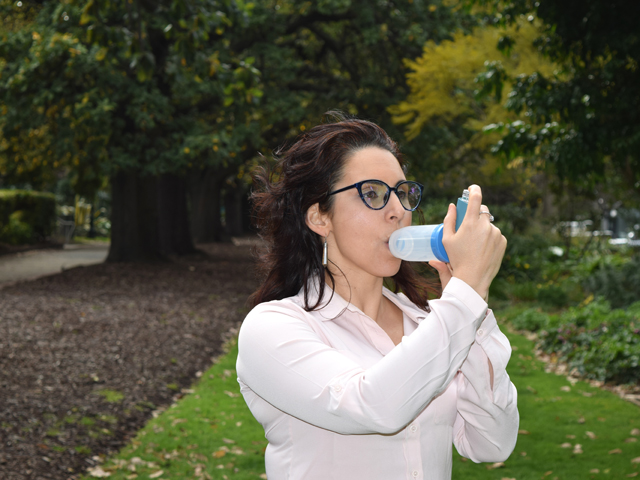Siobhan Brophy Asthma and Allergy Triggers Interview

Spring into Action during Asthma and Hay Fever Season
National Asthma Week launches as a timely reminder that for the one in 10 Australians with asthma and three in four who also have hay fever it not only means sneezing, runny noses and itchy eyes but an increased risk of asthma flare-ups.
This week the National Asthma Council is urging anyone with asthma and hay fever to talk to their GP or pharmacist about how they can keep safe during Spring and thunderstorm asthma season, which occurs from October to December in south-eastern Australia.
National Asthma Council CEO Siobhan Brophy says that while most people know pollen, dust mites and pet dander can trigger hay fever, they may not be aware it can also cause asthma symptoms and serious flare-ups.
'People who are allergic to grass pollens, particularly ryegrass, can have asthma flare-ups caused by springtime thunderstorms, especially if their asthma is not well controlled or they're not taking regular preventer medication for their asthma.
'If you have allergies and you're wheezing or coughing, it's really important to visit your GP so you can work together on a treatment plan to help manage your allergies and asthma and make sure you know what to do during a Spring thunderstorm or asthma emergency,' she says.
Preventive steps for people at risk include following their doctor's advice for using a hay fever nasal spray, asthma preventer, or both, particularly from the last weekend in September until New Year's Day.
After visiting a GP or pharmacist to talk about asthma and hay fever control, there are also some simple steps people can take to reduce their triggers during Spring:
Check the pollen forecast and be extra careful on high pollen days
Use your preventer medications as prescribed and keep your asthma reliever with you
Don't mow grass yourself and stay inside when it is being mown. If you must mow, wear a mask or consider taking a non-drowsy antihistamine if your GP says to.
Consider planting low-allergen plants in your garden that are pollinated by birds or insects.
On high pollen days, extra steps may include:
Try to avoid going outdoors, especially on windy days or after thunderstorms.
Keep windows closed when in your car and consider using recirculating air conditioning.
Keep windows closed at home and consider using an air purifier.
Don't dry washing on an outside clothesline as pollen in the air can end up on clothes.
For easy-to-follow information on how to manage your hay fever and asthma and prepare yourself for thunderstorm asthma season visit National Asthma Council's website: www.nationalasthma.org.au.
 Interview with Siobhan Brophy, CEO of National Asthma Council Australia
Interview with Siobhan Brophy, CEO of National Asthma Council Australia
Question: What signs and symptoms are associated with hay fever?
Siobhan Brophy: One in five Australians with hay fever will usually experience a blocked or runny nose during Spring, and can even feel itchy or sore around the nose, mouth and throat too. This can lead to poor or disturbed sleep and can cause real problems with concentration at work or school.
Question: Why is Spring the worst time for those with hay fever?
Siobhan Brophy: During Spring there are lots of tiny pollen grains, and in particular ryegrass, floating around in the air which when breathed in cause the nose, back of the mouth and throat to become irritated and inflamed and this in turn makes hay fever a lot worse. These tiny grains can also get into the lungs which can trigger asthma flare-ups.
Question: How can Australians reduce their asthma and allergy triggers during Spring?
Siobhan Brophy: People at risk of hay fever and asthma should follow their doctor's advice for using a hay fever nasal spray, asthma preventer, or both, particularly from the last weekend in September until New Year's Day.
While visiting a GP or pharmacist to talk about asthma and hay fever symptoms and how you can control them is the first step in reducing your triggers there are also a few simple steps you can take during Spring such as:
Checking the pollen forecast and being extra careful on high pollen days
Using your preventer medications as prescribed and keeping your asthma reliever with you at all times
Not mowing grass yourself and staying inside when it is being mown. If you have to mow it's best to wear a mask or consider taking a non-drowsy antihistamine if your GP says to.
Question: How do allergies increase asthma symptoms?
Siobhan Brophy: At least 3 out of 4 people who have asthma also have hay fever as the two conditions are related and when combined together can cause serious flare-ups.
Hay fever can make asthma harder to control and asthma triggers such as pollen, cold air, cigarette smoke, etc also make hay fever worse. We also know that people who have asthma and hay fever experience more visits to hospital or emergency departments and are more likely to take time off work or school than other people with asthma, so it's really important to get effective treatment for your hay fever as well as asthma.
Question: Can you tell us about thunderstorm asthma season?
Siobhan Brophy: Thunderstorm asthma season occurs predominately in south-eastern Australia from October to December however thunderstorm asthma can happen suddenly to people in spring or summer when there is a lot of pollen in the air and the weather is hot, dry, windy and stormy.
People with asthma and/or hay fever need extra protection to avoid thunderstorm asthma which means using preventer medicine every day, always having a reliever inhaler (blue puffer) ready, and visiting your doctor to come up with a treatment plan that suits you.
Question: How can those with asthma protect themselves ahead of thunderstorm asthma season?
Siobhan Brophy: On high pollen days it's important for people with asthma and hay fever to take precautions including the following:
Try to avoid going outdoors, especially on windy days or after thunderstorms.
Keep windows closed when in your car and consider using recirculating air conditioning.
Keep windows closed at home and consider using an air purifier.
Question: What's the main message you hope to spread ahead of National Asthma Week?
Siobhan Brophy: For the one in 10 Australians with asthma and three in four who also have hay fever Spring doesn't just mean sneezing, runny noses and itchy eyes but can also increase the risk of serious asthma flare-ups.
Anyone with asthma and hay fever should to talk to their GP or pharmacist about how they can keep safe during Spring and thunderstorm asthma season.
Interview by Brooke Hunter
MORE



